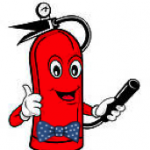Antibiotic-resistant infections: Life without fire extinguishers (Guest blog)
06.06.16
As antibiotics began to be introduced, their life-saving effects were instantly obvious and, as a happy consequence, death from bacterial infections rapidly became a concept limited almost entirely to historical novels.
Antibiotics are the fire extinguishers of medicine

In The Lancet in 2016, Rex and Outterson suggested that in many ways, antibiotics quickly became the fire extinguishers of medicine. The analogy of infection to a fire is striking: both progress rapidly (minutes matter!); and require immediate action. When a fire occurs, it is too late to start building a fire station or installing a fire extinguisher. Adequate antibiotics and fire extinguishers must be instantly ready on a nearby wall.
Moreover, the availability of adequate antibiotics has transformed medicine. Their power makes it possible to treat cancer, replace hips, and take care of premature infants. Nevertheless a few fires still occur. When this happens, the fire extinguisher on the wall saves the day.
The emergence of AMR Life without fire extinguishers?
Bacteria have, though, responded to the use of antibiotics by mutating and becoming resistant to antibiotics. The creation of new agents enabled us for many years to outpace AMR, but the speed of new drug development has slowed almost to zero, resistance has become widespread, and we now face the possibility of life without fire extinguishers. By 2050, one project suggests that annual deaths might rise from 700,000/year to 10 million/year and the net cost to the globe would be a $100t loss in GDP.
Taking action
Over a decade’s worth of discussion and analysis of this topic has stimulated the global conversation and made four things clear:
- Discovering new antibiotics is very hard. If we are lucky, a small stream of new antibiotics will emerge in the coming years – but only a small stream.
- Developing new antibiotics is surprisingly complicated. Although regulatory agencies have responded to the AMR crisis of by updating and streamlining their approaches, efforts to keep rates of resistant infections low make it hard to study new drugs.
- The economics of antibiotics are not sustainable under current models. Multiple analyses show that the return on investment for new antibiotics is consistently near or below zero.
- The problem of AMR requires a broad systems-level approach: Many factors contribute and there is no single, simple answer.
A good framework for such a systems-level approach to AMR has been proposed by WHO as the core of its Global Action Plan (GAP) for AMR:
- Improve awareness and understanding of antimicrobial resistance
- Strengthen knowledge through surveillance and research
- Reduce the incidence of infection
- Optimize the use of antimicrobial agents
- Develop the economic case for sustainable investment that takes account of the needs of all countries, and increase investment in new medicines, diagnostic tools, vaccines and other interventions
2016: The year for action
As noted recently by WHO Assistant DG Keiji Fukuda: “This may be the most important year for AMR that we’ve had in our lifetime.”
Multiple calls to action have buoyed stakeholders into taking action. The actions are diverse and include: better infection control; improved food and water safety; better use of vaccines; increased public awareness; and reduced use of antibiotics in animal agriculture.
New business models for Industry: Fire extinguisher have value even when not used
From industry’s standpoint relative to development of new therapeutics, the #1 required action is a reinvention of the business models we use for antibiotics. The core concept is that of delinkage: we need novel payment models to avoid relying exclusively on the use of sales- and volume-based reward models. Stated differently, we should reduce the link between the profitability of an antibiotic and the volume sold.
In fire extinguisher terms, the current approach to rewarding innovation is tantamount to paying for the fire extinguisher only when you actually use it. In reality, the fire extinguisher has value simply in being on the wall — but we currently do not reimburse for antibiotics in a way that recognises this.
A recent Industry-wide declaration (100+signatories, and growing, http://amr-review.org/industry-declaration) seeks to work with governments to develop new and alternative market structures that provide more dependable and sustainable models for antibiotics and to commit the funds needed to implement them.
As part of the effort to develop such alternative models, the DRIVE-AB was initiated in October 2014. An Innovative Medicines Initiative (IMI)-funded project, DRIVE-AB seeks to:
- Identify useful metrics for responsible antibiotic use and
- Identify new economic models to incentivise the discovery and development of new novel antibiotics for use now and in the future
At a 2 June 2016 conference, over 200 diverse stakeholders met to review the work of DRIVE-AB. Participants came from all parts of the globe and all key stakeholder organisations (among them governments, institutions, funders, charities, pharmaceutical companies and health technology assessment bodies).
From words to action: Thinking globally, acting locally
All the pieces are in place for successful global action vs. AMR. With this, it is not too late to avert potential consequences in a world without fire extinguishers. It is, though, going to take concerted action to make this happen.
Although globally-led solutions might be optimal in a perfect world, they may never come to being. And for many aspects of AMR, there is no single solution that works well in all territories: one size does NOT fit all. Thus, it is critical that individual countries and stakeholders recognise the global principles for action and proceed to taking steps now based on the evidence at hand.
The leadership in this regard by the UK, Swedish, and US governments is especially noteworthy: each has invested significant resources in take concrete actions. It is imperative that this trend accelerates!
